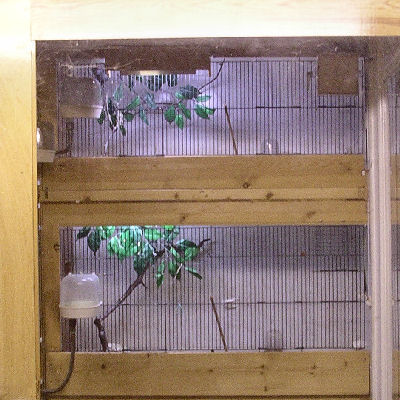Lavender Waxbills
Suitable housing
My pairs are in a variety of cages - all more double breeder size (two shown on the right)
Richard had his pairs in normal single cages. Numerous unpaired birds were kept in 5' cages
The pair that has bred so far is in a double breeder with a large bob-hole connection to a single breeder with a screened front
This set-up is a throw back from Pin-tailed Parrot finch breeding so these birds could escape from me and feel secure
Richard didn't have this and it is noticeable that his birds became more secretive and less friendly in my set-up


Cage or aviary is your choice. I prefer flights
Some articles report 2 to 3 pairs occupying the same territory in the wild, even when breeding
This is somewhat hard to reconcile with the aggression that can be seen with more than one pair in a flight
In the wild the territory is invariably larger than the space available in even a quite large aviary
One pair per enclosure is not recommended
A minor problem is that feather-plucking is common even with a few birds in a large cage. It can even occur between pairs housed singly
The main danger is birds living peaceably in a cage suddenly begin serious fighting when a pair forms and they decide to nest
At this stage I don't know what is best ie cage, flights or aviary, but who can argue with Richard's cage breeding results
Personally, I agree with those who report Lavenders being active and needing space
They look so much more interesting, and interested, when in flights
Temperature & Lighting
Termperature is less controversial. No lower than 15°C/ 60°F, ideally minimum of 18°C - 20°C/ 70°F , for breeding
Light should be at least 12 hours a day (mine is 14), from full spectrum fluorescent tubes
Link here to Arcadia for explanation of the benefits of their Bird Lamps/ tubes
These tubes also bring out the Lavender's colour nicely but need to be replaced annually
Ideally electronic ballast flicker-free fluorescent battens (~ 20,000cps)
My pairs are in a variety of cages - all more double breeder size (two shown on the right)
Richard had his pairs in normal single cages. Numerous unpaired birds were kept in 5' cages
The pair that has bred so far is in a double breeder with a large bob-hole connection to a single breeder with a screened front
This set-up is a throw back from Pin-tailed Parrot finch breeding so these birds could escape from me and feel secure

Richard didn't have this and it is noticeable that his birds became more secretive and less friendly in my set-up
Cage or aviary is your choice. I prefer flights
Some articles report 2 to 3 pairs occupying the same territory in the wild, even when breeding
This is somewhat hard to reconcile with the aggression that can be seen with more than one pair in a flight
In the wild the territory is invariably larger than the space available in even a quite large aviary
One pair per enclosure is not recommended
A minor problem is that feather-plucking is common even with a few birds in a large cage. It can even occur between pairs housed singly
The main danger is birds living peaceably in a cage suddenly begin serious fighting when a pair forms and they decide to nest
At this stage I don't know what is best ie cage, flights or aviary, but who can argue with Richard's cage breeding results
Personally, I agree with those who report Lavenders being active and needing space
They look so much more interesting, and interested, when in flights
Temperature & Lighting
Termperature is less controversial. No lower than 15°C/ 60°F, ideally minimum of 18°C - 20°C/ 70°F , for breeding
Light should be at least 12 hours a day (mine is 14), from full spectrum fluorescent tubes
Link here to Arcadia for explanation of the benefits of their Bird Lamps/ tubes
These tubes also bring out the Lavender's colour nicely
They need to be replaced annually
Ideally electronic ballast flicker-free fluorescent battens (~ 20,000cps)
www.blue-capped-waxbill.com/
www.parrot-finches.com
www.waxbillfinchsociety.org.uk/
www.welcomewildlife.co.uk
www.snorkellingphotography.com





